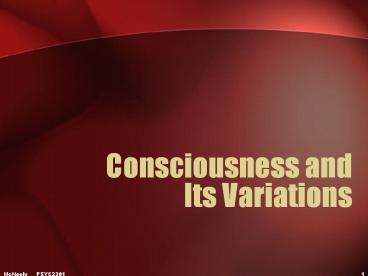Consciousness and Its Variations - PowerPoint PPT Presentation
1 / 30
Title:
Consciousness and Its Variations
Description:
Adaptive theory sleep emerged in evolution to preserve energy and ... sudden arousal from sleep and intense fear accompanied ... Sleep apnea failure to ... – PowerPoint PPT presentation
Number of Views:28
Avg rating:3.0/5.0
Title: Consciousness and Its Variations
1
Consciousness and Its Variations
2
Consciousness
- Described as a stream or river by William James
- Introspection tried to capture the structure of
consciousness - Modern study includes roles of psychological,
physiological, social, and cultural influences
3
Circadian Rhythm
- Any rhythmic change that continues at close to a
24-hour cycle in the absence of 24-hour cues - body temperature
- cortisol secretion
- sleep and wakefulness
- In the absence of time cues, the cycle period
will become somewhat longer than 24 hours
4
Circadian Rhythm
5
The Bodys Clock
- Suprachiasmatic nucleus (SCN)cluster of neurons
in the hypothalamus that governs the timing of
circadian rhythms - Melatoninhormone of the pineal gland that
produces sleepiness - Bright light decreases production of melatonin
decreased light increases melatonin
6
Stages of Sleep
7
EEG Waves
ist-socrates.berkeley.edu/ jmp/dreams.html
8
Sleep Changes Throughout Life
- Changes in quality and quantity are apparent
9
Functions of Sleep
- Restoration theorybody wears out during the day
and sleep is necessary to put it back in shape - Adaptive theorysleep emerged in evolution to
preserve energy and protect during the time of
day when there is considerable danger
10
Sleep Deprivation
- Microsleep--episodes lasting only a few seconds
- REM rebound--deprivation of REM sleep causes
increase in time spent in REM sleep to catch up - NREM rebound--catching up on Stages 3 and 4 sleep
11
Individual Differences in Sleep Drive
- Nonsomniacssleep far less than most, but do not
feel tired during the day - Some individuals need more and some less than
the typical 8 hours per night - Insomniacshave a normal desire for sleep, but
are unable to and feel tired during the day
12
Sleep Disorders
- Insomniainability to fall asleep or stay asleep
- Night terrorssudden arousal from sleep and
intense fear accompanied by physiological
reactions (e.g., rapid heart rate, perspiration)
that occur during slow-wave sleep - Narcolepsyoverpowering urge to fall asleep that
may occur while talking or standing up - Restless Legs Syndrome--RLS unpleasant sensations
in lower legs and urge to move legs disrupts
sleep. - Sleep apneafailure to breathe when asleep
- REM sleep behavior disordersleeper acts out his
or her dreams
13
Dreams and REM Sleep
- True dreamvivid, detailed dreams consisting of
sensory and motor sensations experienced during
REM - Sleep thinkinglacks vivid sensory and motor
sensations, is more similar to daytime thinking,
and occurs during slow-wave sleep
14
Brain and REM Sleep
- Active areas during REM--amygdala and hippocampus
- Inactive areas during REM--frontal lobes and
primary visual cortex - REM sleep plays a role in memory consolidation
15
Significance of Dreams
- Psychoanalytic Interpretation
- Activation Synthesis Model
16
Psychoanalytic Interpretation
- Manifest contentelements of the dream that are
consciously experienced and remembered - Latent contentthe unconscious wishes that are
concealed in the manifest content - Dreams as wish fulfillments
17
Activation Synthesis Model
- Brain activity during sleep produces dream images
(activation) which are combined by the brain into
a dream story (synthesis). Meaning is to be found
by analyzing the way the dreamer makes sense of
the progression of chaotic dream images.
18
Hypnosis
- State of awareness
- Highly focused attention
- Increased responsiveness to suggestion
- Vivid imagery
- Willingness to accept distortions of logic
- Alteration of sensation and perception
19
Hypnosis and Memory
- Posthypnotic suggestion--during hypnosis a
suggestion is made for the person to carry out
some behavior after hypnosis is over - Posthypnotic amnesia--inability to remember
specific information because of a posthypnotic
suggestion - Hypermnesia--enhancement of memory because of
posthypnotic suggestion
20
Meditation
- Sustained concentration that focuses attention
and heightens awareness - Lowered physiological arousal
- decreased heart rate
- decreased BP
- Predominance of alpha brain waves
21
Meditation Techniques
- Concentration techniques--control attention by
focusing awareness on a visual image, word, or
phrase - Opening-up techniques--control attention by
focusing on the here and now
22
Psychoactive Drugs
- Depressantsinhibit brain activity
- Opiatesproduce pain relief and euphoria
- Stimulantsincrease brain activity
- Psychedelicsdistort sensory perceptions
23
Common Properties
- Physical dependence
- Tolerance
- Withdrawal symptoms
- Drug rebound effect
24
Depressants
- AlcoholCNS depressant
- Barbituratesinduce sleep but can cause
dependence and as a result serious withdrawal
symptoms - Tranquilizersrelieve anxiety but can be
addictive - Effects are additive
25
BAC Effects
- Euphoria (BAC 0.03 to 0.12)
- Excitement (BAC 0.09 to 0.25)
- Confusion (BAC 0.18 to 0.30)
- Stupor (BAC 0.25 to 0.4)
- Death (BAC more than 0.50 )
26
Areas of the brain that may be affected by FAS
27
Opiates
- Chemically similar to morphine and have strong
pain-relieving properties, can be addictive - Mimic the brains endorphins
- Heroin, methadone
- Percodan, Demerol
28
Stimulants
- Caffeine
- Nicotine
- Amphetamines
- Cocaine
- Stimulant induced psychosis
29
Psychedelics
- Create perceptual distortions
- Mescaline
- LSD
- Marijuana
- Flashback reactions and psychotic episodes
30
Club Drugs
- Ecstasy (MDMA)feelings of euphoria, increased
well-being - Side effectsdehydration, hyperthermia, tremor,
rapid heartbeat - Dissociative anestheticsinclude PCP and
Ketamine. Deaden pain, produce stupor or coma,
and may induce hallucinations.

